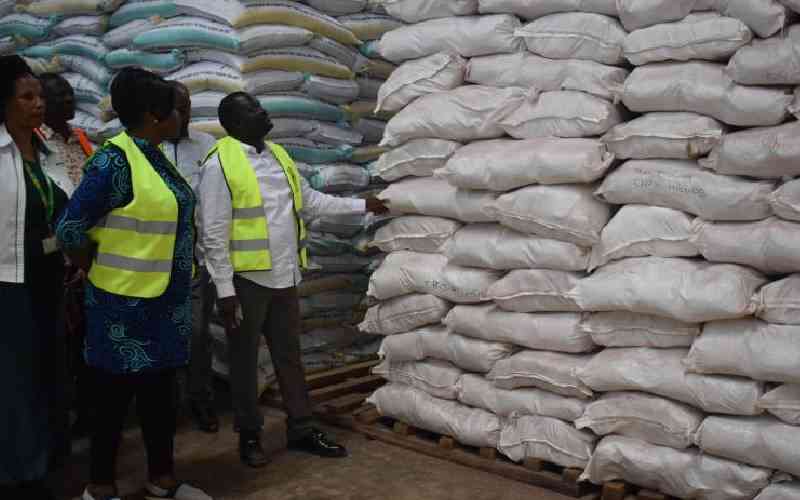By Lucianne Limo
Homosexuality among prisoners is rife and it is contributing to the high HIV and Aids prevalence among inmates, a survey on the Kenyan jails reveals.
With the overcrowding and little food, some inmates have to negotiate to get additional food or even a comfortable spot in the cells to sleep in exchange for sex.
So if a prisoner doesn’t have bread and the next one has, he is forced to just ‘tango’, the survey shows.
The Kenya Prison Service recognised that sodomy occurs in prisons and commissioned Liverpool VCT Centre to establish the nature and prevalence of the practice. The results were shocking.
The centre conducted a research in 13 male facilities countrywide between April and May last year where 772 inmates were interviewed.
The report, titled Sexual Health and HIV Knowledge, Practice and Prevalence Among Male Inmates in Kenya, revealed that sodomy is rife in prisons.
Inmates practice anal and oral sex and masturbation, it showed.
Anal sex, which was widely mentioned by 648 inmates, had different local names such as ‘umende,’ ‘ushoga’ and ‘ulawiti’.
According to the report, the general awareness by most inmates that anal sex takes place is a pointer to its popularity.
Sexually Active Inmates
Inmates were asked whether they were sexually active prior to and after imprisonment. Out of the 59 who had sex during their incarceration, 44 (74.6 per cent) were first time prisoners. Only three were from the borstal institutions and the rest, 56, were from the main prisons.
Of those who had sex while in prison, 42 perceived themselves as having low chances of contracting HIV in prison while 17 thought the chances were high.
A total of 410 inmates attended VCT’s out of which 37 (9 per cent) had sex in prison and five out of the 37 tested HIV positive.
The report indicated that most inmates engaging in the vice did not speak about it due to stigma and, therefore, the number of those involved may be higher than reported. Twenty-three key informants including representatives from prisons noted that sex is the main mode of HIV transmission among inmates.
Stay informed. Subscribe to our newsletter
When the inmates were asked the number and type of sexual partners they have had, six said they had between one and four partners in prison within the last 12 months preceding the study.
On the role they played during sexual intercourse, 13 said they were recipient partners, seven were ‘insertive’ and four said they were both ‘insertive’ and recipient.The report indicated that unprotected receptive anal sex carries the highest risk for HIV infection because the rectum which is the part of the colon behind the anal sphincter has no lubrication, has a large absorbent surface area and the tissue is very delicate and thus tears and bleeds very easily.
Rape In Jail
Of the 59 inmates who indicated they had engaged in sex, 21 reported having consented to the act while two were raped. Five inmates received favours such as food, money or cigarettes in exchange for sex, while the rest declined to state the type of negotiation they had prior to engaging in sex.
Some prison officials acknowledged that consensual anal sex does occur.
Most, however, were of the view that rape is also prevalent. They also reported that the victims are usually new inmates who are initiated into prison life either by being raped or intoxicated with drugs prior to the sodomy ordeal.
"Because some of the inmates are weak they are not able to resist the bullies," the report adds.
Some inmates were unknowingly induced into drugs by colleagues only to realise later that they had been sexually violated.
The report states that the use of drugs to induce inmates into sex endangers the lives of both the perpetrator and the victim, since it exposes them to HIV infection and other sexually transmitted diseases.
"The psychological torture that goes with such treatment is insurmountable. Young offenders were more vulnerable to sexual abuse," the report states. According to key informants, some inmates demanded sex so that they can give out food in exchange or exempt fellow inmates from certain duties.
Dominance and bullying of new inmates is a main reason for non-consensual sex.
"Hardcore criminals take advantage of new ones. They have a link between kitchen where they prepare food and "mjumbes" who are in charge of the kitchen and to lure the new ones who are hungry they use that food sometimes to accept homosexuality," a respondent is quoted saying.
Transactional Sex
Twenty-one inmates (2.9 per cent) admitted practicing transactional sex where inmates paid or received money/food or other favours in exchange of sexual favours. A majority of the inmates 321 (44.5percent) said they had done it prior to incarceration.
An inmates’ pre-imprisonment lifestyle or the offence one is convicted of was also cited as contributing to sex in prison. For example, according to some key informants, convicts of sexual offences were likely to continue with the same practice in jail.
Consensual sex was also linked to the long duration inmates spend in incarceration. Inmates are at times bored so they engage in sex. The financially endowed inmates use money as a bait to solicit sex especially from newly incarcerated inmates.
Officers interviewed associated the perpetuation of the practice to extreme overcrowding and mixing of minors with adult offenders.
Lack of money to purchase personal effects and poor food rationing were also given as reasons that prompt inmates to trade off food for sex.
"Engagement in sexual offences is a reflection of what is happening in the general population. The inmates are products of the larger society," a key informant is quoted saying.
Besides engaging in sexual behaviour, inmates were also asked about other practices that may put them at risk of HIV infection such as sharing of syringes, tattooing and drug and alcohol consumption.
They conceded to using different types of drugs while in prison. Forty-one percent said they had used a variety of drugs before incarceration for non-medical purposes while 18.42 percent said they had used drugs while in prison. Eighteen percent of all HIV positive inmates had used drugs for non-medical reasons prior to imprisonment.
They had used illegal drugs such as bhang, artane, marijuana, C5, D5, D6, Carbon, Cosmos, heroine (brown sugar), C-yellow cake, Cuber among others, both before and during imprisonment.
Bhang was the most common drug in prison.
 The Standard Group Plc is a
multi-media organization with investments in media platforms spanning newspaper
print operations, television, radio broadcasting, digital and online services. The
Standard Group is recognized as a leading multi-media house in Kenya with a key
influence in matters of national and international interest.
The Standard Group Plc is a
multi-media organization with investments in media platforms spanning newspaper
print operations, television, radio broadcasting, digital and online services. The
Standard Group is recognized as a leading multi-media house in Kenya with a key
influence in matters of national and international interest.
 The Standard Group Plc is a
multi-media organization with investments in media platforms spanning newspaper
print operations, television, radio broadcasting, digital and online services. The
Standard Group is recognized as a leading multi-media house in Kenya with a key
influence in matters of national and international interest.
The Standard Group Plc is a
multi-media organization with investments in media platforms spanning newspaper
print operations, television, radio broadcasting, digital and online services. The
Standard Group is recognized as a leading multi-media house in Kenya with a key
influence in matters of national and international interest.





